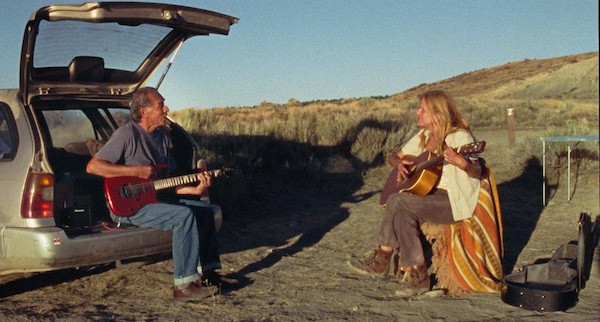Max Walker-Silverman’s directorial debut, A Love Song, emerges not as a blockbuster spectacle, but as a tender, introspective piece that speaks to a generation yearning for depth and simplicity. In a cinematic landscape often dominated by explosive action and convoluted narratives, this film offers a refreshing counterpoint, inviting viewers to savor the quiet moments and profound emotions of everyday life.
 Wes Studi, left, with Dale Dickey in *A Love Song*. Photo: Bleecker Street
Wes Studi, left, with Dale Dickey in *A Love Song*. Photo: Bleecker Street
A Deliberate Pace in a Hectic World
In an era where films often equate excitement with frenetic editing and overwhelming CGI, A Love Song dares to be different. It embraces a deliberately slow pace, allowing the story to unfold organically and the characters to breathe. This approach, reminiscent of classic humanist cinema, might feel unconventional to audiences accustomed to the rapid-fire storytelling of modern blockbusters, but it is precisely this measured rhythm that allows the film’s emotional nuances to truly resonate. Director Max Walker-Silverman consciously chooses contemplation over chaos, offering a cinematic experience that encourages reflection rather than sensory overload.
Character-Driven Narrative: Faye and Lito’s Encore
At its heart, A Love Song is a character study, focusing on Faye (Dale Dickey) and Lito (Wes Studi), two individuals in the twilight of their lives. Both seasoned actors bring a quiet dignity and depth to their roles, portraying characters shaped by time and experience. The narrative gently revolves around Faye’s wait at a secluded campsite for Lito, a former love from her youth. This simple premise becomes a canvas for exploring themes of reconnection, memory, and the enduring nature of love in its various forms. The film beautifully illustrates how love can re-enter and re-exit our lives, leaving indelible marks and shaping our journeys.
Echoes of Nature: An Ecological Backdrop
The film’s setting in the breathtaking landscape of southwest Colorado is more than just a backdrop; it’s an integral part of the narrative. Walker-Silverman’s upbringing in Telluride clearly informs his deep appreciation for nature, which is palpable throughout A Love Song. The film is imbued with a sense of ecological awareness, showcasing the beauty and tranquility of the natural world. Heavenly shots of the lake, mountains, and starlit skies not only provide visual splendor but also mirror the characters’ inner landscapes and the cyclical nature of life and love. This connection to the environment underscores the film’s humanist themes, suggesting a harmony between human emotions and the rhythms of the natural world.
Simplicity and Subtlety: A Departure from the Maximalist Trend
A Love Song stands in stark contrast to the maximalist tendencies prevalent in contemporary cinema. It intentionally avoids grand gestures, dramatic confrontations, and excessive plot complexities. There is no violence, no high-speed action, and even the potential for intimacy is handled with restraint and sensitivity. This minimalist approach allows the film to focus on the subtle nuances of human interaction and the unspoken emotions that often lie beneath the surface. The power of A Love Song resides in its quiet moments, in the lingering glances and understated conversations between Faye and Lito, reminding us that profound emotions can be conveyed with remarkable subtlety.
A Love Song for a Different Generation
Walker-Silverman himself describes the film as “a present… to someone of my generation,” and this sentiment resonates deeply. A Love Song is likely to appeal to viewers who appreciate character-driven stories, thoughtful pacing, and films that prioritize emotional depth over spectacle. While younger audiences, accustomed to the adrenaline rush of Marvel movies and fast-paced narratives, might find its gentler rhythm challenging, for those seeking a more contemplative and emotionally resonant cinematic experience, A Love Song offers a welcome and enriching alternative. It’s a reminder that cinema can be a space for quiet reflection, for exploring the complexities of human relationships, and for finding beauty in the simplicity of life’s gentle melodies.
